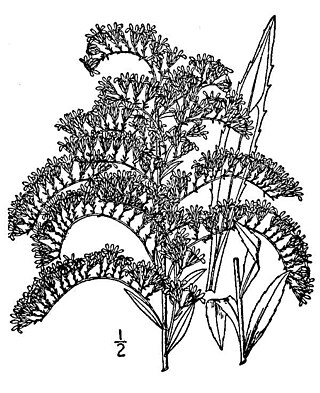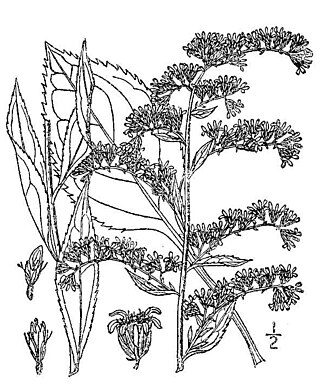
Xerophyllum asphodeloides is a North American species of flowering plants in the Melanthiaceae known by the common names turkey beard, eastern turkeybeard, beartongue, grass-leaved helonias, and mountain asphodel. It is native to the eastern United States, where it occurs in the southern Appalachian Mountains from Virginia to Alabama, and also in the Pine Barrens of New Jersey.

Solidago canadensis, known as Canada goldenrod or Canadian goldenrod, is an herbaceous perennial plant of the family Asteraceae. It is native to northeastern and north-central North America and often forms colonies of upright growing plants, with many small yellow flowers in a branching inflorescence held above the foliage. It is an invasive plant in other parts of the continent and several areas worldwide, including Europe and Asia. It is grown as an ornamental in flower gardens.

Solidago flexicaulis, the broadleaved goldenrod, or zigzag goldenrod, is a North American species of herbaceous perennial plants in the family Asteraceae. It is native to the eastern and central parts of the United States and Canada, from Nova Scotia west to Ontario and the Dakotas, and south as far as Alabama and Louisiana. It grows in a variety of habitats including mesic upland forests, well drained floodplain forests, seepage swamp hummocks, and rocky woodlands.

Solidago shortii, commonly known as Short's goldenrod, is a species of goldenrod in the family Asteraceae. The only known populations of Short's goldenrod occur around the Blue Licks Battlefield State Park area of Kentucky and Harrison-Crawford State Forest in Indiana. It was listed on the Federal Register of Endangered Species on September 5, 1985, and was given a global rank of G1 on February 29, 2000.

Solidago nemoralis is a species of flowering plant in the family Asteraceae. It is native to North America, where it is widely found in Canada and the United States. Its common names include gray goldenrod, gray-stem goldenrod, old-field goldenrod, field goldenrod, prairie goldenrod, dwarf goldenrod, and dyersweed goldenrod.

Solidago altissima, the tall goldenrod or late goldenrod, is a North American species of goldenrod in the family Asteraceae which is widespread across much of Canada, the United States, and northern Mexico. It is common in much of its range and fairly tolerant of landscapes which have been disturbed by humans. It has become naturalized in many parts of the world.

Solidago californica is a species of goldenrod known by the common name California goldenrod.

Solidago houghtonii is a rare North American species of flowering plant in the family Asteraceae known as Houghton's goldenrod. It is native to southern Ontario, Canada and the northern United States. It is threatened by the loss and degradation of its habitat. It is a federally listed threatened species of the United States and it is designated a species of special concern by Canada's Committee on the Status of Endangered Wildlife in Canada.

Solidago villosicarpa is a species of flowering plant in the family Asteraceae known by the common names hairy-seed goldenrod, coastal goldenrod, glandular wand goldenrod, and shaggy-fruit goldenrod. It is endemic to North Carolina in the United States, where there are only four known populations.

Solidago odora, the sweet goldenrod, anisescented goldenrod or fragrant goldenrod, is a North American species of goldenrod within the family Asteraceae. The plant is native to the United States and Mexico, found in every coastal state from Veracruz to New Hampshire and as far inland as Ohio, Missouri, and Oklahoma. It flowers from July through October.

Solidago velutina, the threenerve goldenrod or velvety goldenrod, is a plant species native to Mexico and to the western United States. The species has been found in southwestern Oregon, east to the Black Hills of South Dakota, and as far south as México State in the central part of the Republic of México. It is classified as a member of Subsection Nemorales.

Solidago arguta, commonly called Atlantic goldenrod, cut-leaf goldenrod, and sharp-leaved goldenrod, is a species of flowering plant native to eastern and central North America. It grows along the Gulf and Atlantic states of the United States from Texas to Maine, inland as far as Ontario, Illinois, and Kansas. It is primarily found in areas of woodland openings, such as outcrops or clearings.

Solidago simplex, the Mt. Albert goldenrod or sticky goldenrod, is a North American plant species in the genus Solidago of the family Asteraceae. It is widespread across much of Canada, parts of the United States, and northeastern Mexico.

Solidago rigida, known by the common names stiff goldenrod and stiff-leaved goldenrod, is a North American plant species in the family Asteraceae. It has a widespread distribution in Canada and the United States, where it is found primarily east of the Rocky Mountains. It is typically found in open, dry areas associated with calcareous or sandy soil. Habitats include prairies, savannas, and glades.

Solidago hispida, the hairy goldenrod, is North American species of flowering plants in the family Asteraceae. Its native range extends from Newfoundland west to Saskatchewan, and south as far as Oklahoma, Louisiana, and Georgia.

Solidago latissimifolia, common name Elliott's goldenrod, is North American species of flowering plants in the family Asteraceae. It is native to the Atlantic Coast of the United States and Canada, from Nova Scotia south to Alabama and Florida.
Solidago leavenworthii, or Leavenworth's goldenrod, is North American species of herbaceous perennial plants of the family Asteraceae. It is native to southeastern United States from Florida north to Georgia and the Carolinas.

Solidago nana is a North American plant species in the family Asteraceae, with the common names baby goldenrod and dwarf goldenrod. The species is native to deserts and mountainsides in the western United States, from the Rocky Mountains to the Great Basin in the states of Idaho, Montana, Nevada, Utah, Wyoming, Colorado, Arizona, and New Mexico.

Solidago radula, the western rough goldenrod, is a North American plant species in the family Asteraceae. It is found primarily in the southern Great Plains and the Mississippi Valley of the United States, with isolated populations farther east in Kentucky, Georgia, and the Carolinas.
Solidago rupestris , the rock goldenrod or riverbank goldenrod, is a North American species of flowering plants in the family Asteraceae. It is found in the eastern United States, found today in the States of Maryland, Virginia, Kentucky, and Tennessee. There are historical records of it formerly growing in Indiana and Pennsylvania as well, but these populations now appear to have been extirpated.



















